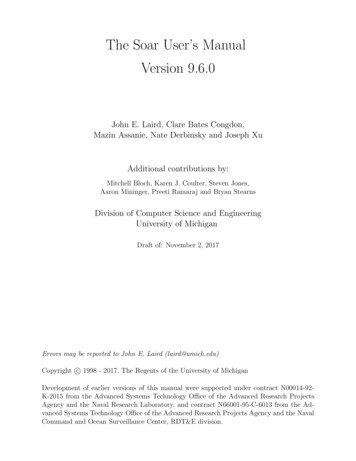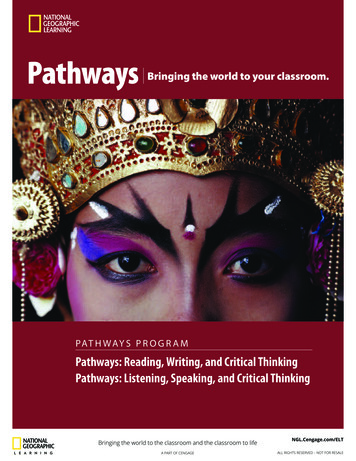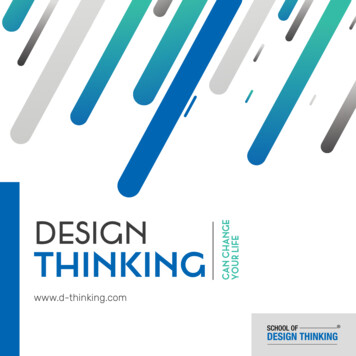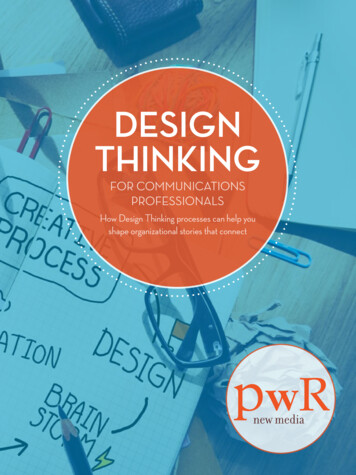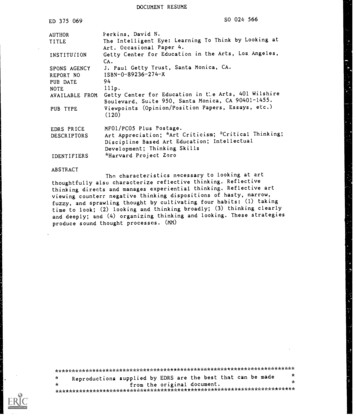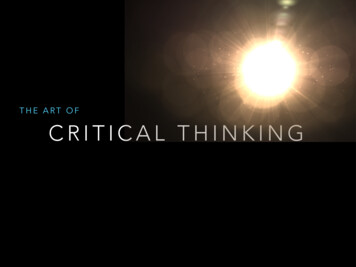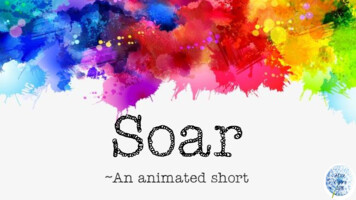
Transcription
Soar An animated shortAliceVigors2018
For the Teacher The animation Soar is a digital text that can be used to helpexplore the idea of a growth mindset and developingperseverance with students. This animated short can alsoprovide a great base to explore many aspects of the 3-6Alice Vigors2018OtherGrowthMindsetLessonIdeas
Soar AnimationBackAlice Vigors2018About theAnimation
Soar AnimationFind out more about the animation by clicking the buttonsbelow:StoryBackCharactersAlice Vigors2018Production
BackEnglishLesson IdeasYears K-2AliceVigors2018
Before Initial ViewingReading & Viewing:Comprehension-Predicting: Display the title and an image from theanimation. Ask students to make predictions about whatmight occur in the digital animation. Record initial predictions as a class and/orstudents recording a visual/ written predictionSpeaking & Listening: Share initial predictions including reasons whythis prediction was made – partner share thenclass shareSpelling: Explore the meaning of the word soar Create and sort a list of words that rhyme withsoarDuring Initial ViewingSpeaking & Listening: Watch the first minute of the animation anddiscus how it compares to their predictions –similarities and differencesReading & Viewing: See Think Wonder thinking routine What are the things that you see, observe or notice inthis animation? What does it make you think will happen next? Why do you think this might have happened? What does it make you wonder?Writing & Representing: Pause the animation at 1:05 Compose the next part of the story Establish bookwork expectations Develop a success criteria for writing Share writing NB: More information about the thinking routine See Think Wonder can be foundon my website: htmlAlice Vigors2018
After Initial ViewingFurther Learning ExperiencesSpeaking & Listening: Discus: How did your ending compare to theLinks to STEM: Design a new flying machine for Lucas anddescribe itanimation?Writing & Representing: Write a description of one of the characters orthe flying ship and illustrate. Share writingBack Design own paper plane and have a FUN paperplane throwing competitionAlice Vigors2018 Whose plane can travel the furthest distance? What items can we use to measure the distance? What’s the difference between the longest throw andthe shortest? Does the answer depend on the type of object used tomeasure?EnglishResources
See Think Wonder- Thinking RoutineSeeThinkWonderWhat are the things that you see,observe or notice in thisanimation?What does it make you think will happennext?Why do you think this might havehappened?What does it make you wonder?Adapted by Alice Vigors 2017
BackEnglishLesson IdeasYears 3-6AliceVigors2018
Before Initial ViewingReading & Viewing:Comprehension-Predicting: Display the title and an image from the animation. Ask students to make predictions about whatmight occur in the digital animation. Record initial predictions in a predictionflowchartSpeaking & Listening: Share initial predictions including reasons whythis prediction was made – partner share thenclass shareSpelling: Brainstorm words related to the word soar, e.g.flying. Extension: Sort the brainstormed wordsaccording to different categories, e.g. letterpatterns, meanings etc.Alice Vigors2018During Initial ViewingReading & Viewing:Comprehension-Predicting: Begin watching the beginning of the animatedshort, stopping at set intervals to review andrevise current predictions using the predictionflowchart. 27 seconds 49 seconds 56 secondsSpeaking & Listening: Share revised predictions including reasons whythis prediction was made – partner share thenclass shareWriting & Representing: Pause the animation at 1:05 Compose the next part of the story Establish bookwork expectations Develop a success criteria for writing Peer edit writing using editor’s code & 2 stars & awish Share writing
After Initial ViewingSpeaking & Listening: Discus: How did your ending compare to theanimation?Reading & Viewing:Comprehension-Connecting: Using a Venn diagram students compare andcontrast their written piece to the actualending of the animation.Further Learning ExperiencesThemes & Messages: Explore what a theme is a theme is themessage or lesson that the author wants you tolearn from the story. The theme is ofteninferred. What themes are present in this animation? What did the characters learn? Did all the characters learn the same thing? How did the characters grow throughout theanimation? How does this animation fit with what we knowabout growth vs. fixed mindset? What message can we take from this animationand how might it apply to our lives?Alice Vigors2018
Further Learning Experiences Further Learning ExperiencesReading & Viewing:Comprehension-Inferring & Synthesising: Use the thinking routine Step Inside to digdeeper and uncover the complexity behind oneof the characters and their actions.Writing & Representing: Retell the story from the point of view of Maraor Lucas. Use the step inside to help youexamine things from their point of view. Compose a ‘flashback’ scene that tells us moreabout Lucas and his lifeConnecting to other texts: Mute the sound on the animation and play thesong Believe in Yourself by the Hot PotatoBand whilst the animation is playing Give students a copy of the lyrics and listen tothe song again. Discuss connections to Soar animation & thecharacters. How does this song connect to the animationsoar? Record thinking. Use the thinking routineGive One, Get One to share and gain newideas. Use the thinking routine Connect ExtendChallenge to explore the connections betweenthe two texts.NB: More information about the thinking routine Step Inside can be foundon my website: NB: More information about the thinking routine Connect Extend Challengeor Give One Get One can be found on my .com/giveonegetone.htmlEnglishBackAlice Vigors2018Resources
Prediction FlowchartMake predictions about the text and provide evidenceabout why that prediction was made.Revised or newprediction What makes you thinkthis?Revised or newprediction What makes you thinkthis?My initial prediction Revised or newprediction What makes you thinkthis?Adapted by Alice Vigors 2017
What does this charactercare deeply about? Howdo you know? Giveevidence.Adapted by Alice Vigors 2017What puzzles thischaracter throughout thetext? What questionsarise for you about thischaracter or theiractions?Why do they think these events haveoccurred? What is their role in theseevents?Character:What does the character see, observeor notice throughout the text?Step Inside
Give One, Get One - Thinking Routine Give students a topic, prompt or question to respond to. Students record their responses. Students stand up and find someone from another table or partof the room. Share one of your ideas with your partner. Get one idea from your partner – has to be a new idea. Askthem ‘Why is that important?’ or ‘Why did you make thatconnection’? Record your partners idea & reasoning. Repeat with up to two more people.Adapted by Alice Vigors 2017
Connect Extend Challenge - Thinking RoutineConnectExtendChallengeWhat immediate connectionscame to mind for you betweenSoar and the lyrics?How has our learning extendedyour thinking about the animationor a character?What questions or challenges doyou have as you try tounderstand these texts?Adapted by Alice Vigors 2017
BackOther GrowthMindset LessonIdeasAliceVigors2018
Paper TaskInstructions:Tim Bowman – Founder Class CreatorBefore your students enter the room place acouple of these in a place where each studentcan easily view it from all sides.Materials: scissors, scrap paperInstruct students they cannot touch the structure, but theyare encouraged to move around it and view it from allangles. Encourage students to discuss their ideas andmethods as they go, but if they are successful, they are tokeep their method to themselves.While the kids are working on it walk around the classroomand monitor their behaviour and language. I write downthe language I hear and take photos of the kids working.After about 5 or so minutes start writing the language youhave heard on the board.1.2.Use a rectangular piece of paperFold in ½ along the long side & unfold it again3.Make 3 cuts using scissors – 2 on one side and 1 on theother4.Twist the paperAt the end discuss the activity: Did anyone make it? How long did it take? How manytries? What was it like when someone else got it? How long did you look at the structure before youstarted? Did you look at what others were doing? Did you learnanything from what they were doing?Alice Vigors2018
Diamond Nine Display 9 different words and discuss their meaningaccording to the characteristic of effective learning,e.g. perseverance, distractions etc. Pairs: think about and sort words according toimportance of an effective learner. Discuss choicesand make note of final decisions including reasonsfor their choices. Teams of 4: discuss choices each pair made and tryto develop a shared Diamond 9 – convincing group ofchoices including justification. Share Thinking: groups share and justify choices.DisplayCan we make a whole class Diamond 9?Or agree on the top 3 words or phrases?NB: Click here for a copy of my Diamond Nine activitytemplateAlice Vigors2018
Mojo & Growth Mindset Videos Episode One: Your brain is like a muscle (click image) Episode Four: The mysterious world of neurons Episode Two: The magic of mistakes Episode Five: Mojo puts it all together Episode Three: The incredible power of yetAlice Vigors2018BackGrowth MindsetResources
Adapted by Alice Vigors 2017
This animated short can also provide a great base to explore many aspects of the English syllabus. Soar Animation English Lesson Ideas K-2 3-6 Other Growth Mindset Lesson Ideas Alice Vigors 2018. Soar Animation About the Back Animation Alice Vigors 2018. Soar Animation

